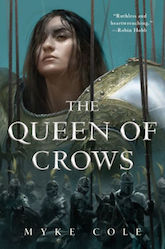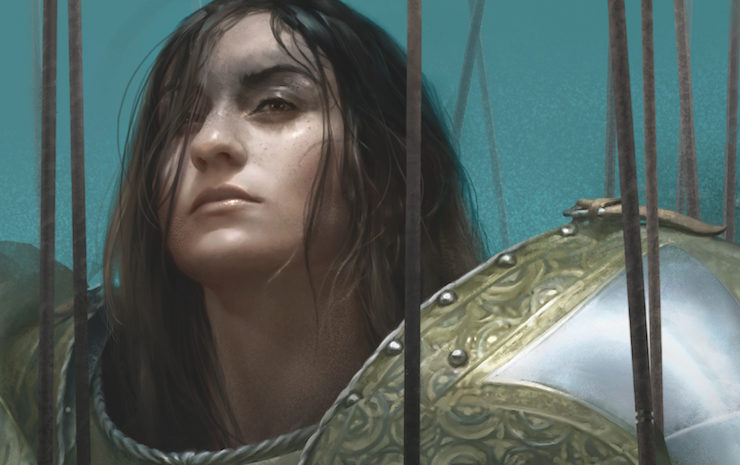Myke Cole surprised readers last year when the author of primarily military fantasy fiction told the grim but complex story of a young woman named Heloise, living in a world where wizardry would summon devils into the world, and only the tyrannical Order could keep the people of the world safe.
In The Armored Saint, Heloise lives in Lutet with her mother and father, and does her best to obey them, help the town where she can, and spend time with her friend Basina, for whom she harbors a love beyond friendship. But throughout the book, we see time and again the brutality of this world: how the Order cuts down any who oppose them, no matter how small the infraction, and how they force other civilians to aid them in “the knitting,” a fancy name for utter destruction of a town and its citizens who they fear have been touched by wizardry.
[Spoilers for book one, The Armored Saint]
And things go from bad to worse when a friend of Heloise’s, a ranger from out of town, uses magic to attack the Order, and he cannot control his powers. A rent to Hell opens, and a devil spills forth. In that battle, Heloise loses Basina, but fights back inside a massive, metallic construct, an exoskeleton of steel and strength. After a horrific battle in which she loses her hand, Heloise wins, the slain devil at her feet, and the people around her whispering of her divinity. For only the holy Palantines have ever killed devils, and so that must be what Heloise is.
The Queen of Crows, the second book in The Sacred Throne trilogy, picks up just where we left off, only a few days removed from the fight with the devil. Heloise has hardly left her armor, her body is wracked with pain, and the Order is on their way to knit the town, as reports have already begun to fly like birds in all directions. There is no time to mourn, to rest, to grieve, or scream. The Order is coming, and everyone looks to Heloise to lead. Her mother and father cannot see her as anything other than their child. Her town cannot see her as anything but an infallible knight sent from the Emperor upon his Sacred Throne to lead them. And all Heloise wants to do is rest. But she can’t. She must move forward, and if it be as a leader, a warrior, or a holy knight, so be it. There is no time to think otherwise.
The relentless intensity of the last act of The Armored Saint carries over into The Queen of Crows, and Cole slowly turns the dial ever higher as the story pushes onward. This is not a story of a world turned upside down; that’s already happened. This is the after, what happens when what you knew is gone, and you must either fight to survive, or give in and die. And Heloise must live, must keep everyone alive. There is no alternative. Heloise consistently finds herself in between a rock and a hard place, faced with decisions that don’t bring her joy, but either make her something she doesn’t think she is, or endanger those she cares for. Cole has never been one to shy away from the complications of leading, or the dangers of fighting back, and he makes sure to show those realities still as Heloise steps up.
Buy the Book


The Queen of Crows (The Sacred Throne)
Nor does he shy away from the more painful realities of those who have been hurt, or abused, or in combat; Heloise’s injuries and her trauma from the first book begin to haunt her, and her mounting paranoia and fear of leaving her war armor will be clear to any who have struggled with PTSD. As she continues to grow and change, Cole is always sure to show us how those decisions affect her and shape her, but he never glosses over the toll her experiences exact. Likewise, Heloise’s queerness is never forgotten; whenever her thoughts turn to Basina, we’re reminded this is a young queer woman standing up and fighting. It is simply who she is, and in those moments when others demand she be different, Heloise cannot satisfy them, and be someone she is not. No matter if you’re a holy saint or a young woman just trying her best, pain is pain, trauma is trauma, and life goes on, no matter how much you wish it would slow down.
But The Queen of Crows isn’t just the story of Heloise. Cole smartly begins to build her world outward, fleshing out secondary characters (some of whom don’t readily accept Heloise as their savior), showing us other cultures and countries beyond Lutet (like the wandering matriarchy of the Kipti), expanding our understanding of the magic that fuels wizardry, and giving a clearer look into the corruption of the institutions trying to smother Heloise and her people. By the book’s end, there is a promise of the world widening even more, as new allies and players make their way to Heloise and her fight against the tyrannical Order.
Cole holds nothing back in his latest installment of The Sacred Throne, and if you enjoyed The Armored Saint, then you’ll absolutely love The Queen of Crows. Heloise’s journey is hard, and filled with pain, violence, grit, and despair, but I can think of no one better to root for, and I eagerly await seeing her journey’s culmination in the next chapter of the series.
The Queen of Crows is available from Tor.com Publishing.
Martin Cahill is a contributor to Tor.com, as well as Book Riot and Strange Horizons. He has fiction forthcoming at Beneath Ceaseless Skies and Fireside Fiction. You can follow his musings on Twitter @McflyCahill90.










